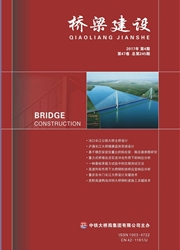

 中文摘要:
中文摘要:
近年来,计算流体动力学(CVD)在桥梁风工程中得到了越来越多的尝试与应用。CFD的应用不仅仅是顺应了计算机硬件浮点运算速度的快速发展,而且在处理复杂问题、时间及经济成本方面与风洞试验相比具有巨大的优越性。但是,这一优越性是建立在CFD求解结果具有实用精度的假设前提下的。该文综述了桥梁气动力CFD数值模拟中湍流问题的起源、各类湍流模型的本质特征及其适用范围与局限性。在此基础上,广泛调研了CFD在国内外桥梁气动力数值模拟中的应用,分别按静气动力与气弹两大类问题统计分析了目前CFD模拟与风洞试验结果之间的差距。结果表明,对于静气动力问题,CFD模拟的误差普遍在10%-40%之间;对于气弹问题,CFD模拟的误差普遍介于20%~300%。这一现实表明,以目前的水平,CFD尚无法独立于风洞试验而对桥梁气弹问题给出可靠的评估。要充分发挥计算流体动力学的优势,则必须结合湍流理论,加强各种湍流模型在各类桥梁气动问题中的应用基础研究。
 英文摘要:
英文摘要:
In recent years, there are more and more applications of computational fluid dynamics (CFD) in bridge wind-engineering, as a result of the rapid development of the floating-point calculation speed of computer hardware. CFD has enormous advantage over the wind-tunnel experiments in terms of the ability of dealing with complex cases, time-consumption, and economic costs. Such advantage, however, must be based on an assumption that the CFD solutions are always of practical accuracy. In this paper, the derivation of the turbulence problem in CFD numerical simulation, the essences of various turbulence models, and limitations and applicability of these models have been summarized. Furthermore, applications of CFD in bridge aerodynamic load simulations worldwide have been investigated, and statistical analysis has been conducted in regard to the simulation errors of the CFD results in comparison with experimental results, presented in terms of aerostatic and aero-elastic classes. The statistics show that, for aerostatic problems, simulation errors of CFD locate generally in the range from 10% to 30%; for aero-elastic problems, however, the errors locate generally from 20% up to as large as 300%. Therefore, the current CFD simulations, when independent on wind tunnel experiments, are incapable of providing reliable assessment of bridge aero-elasticity. To take full advantage of the CFD simulations, it is necessary to strengthen basic investigations regarding the applicability of turbulence models to various bridge aerodynamic issues, in combination with recognition of turbulence theories.
 同期刊论文项目
同期刊论文项目
 同项目期刊论文
同项目期刊论文
 期刊信息
期刊信息
